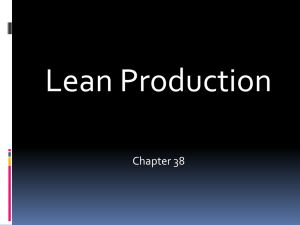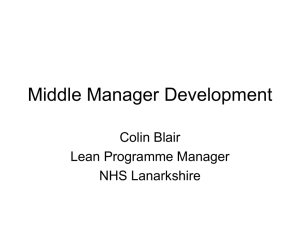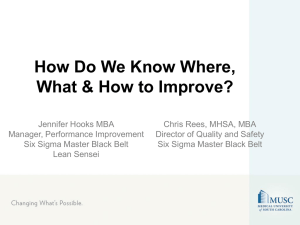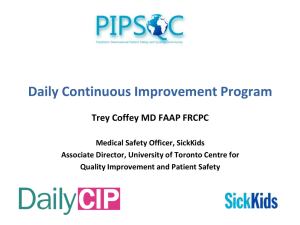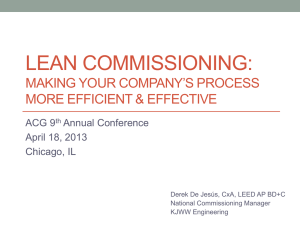Sample - Strategic Lean
advertisement
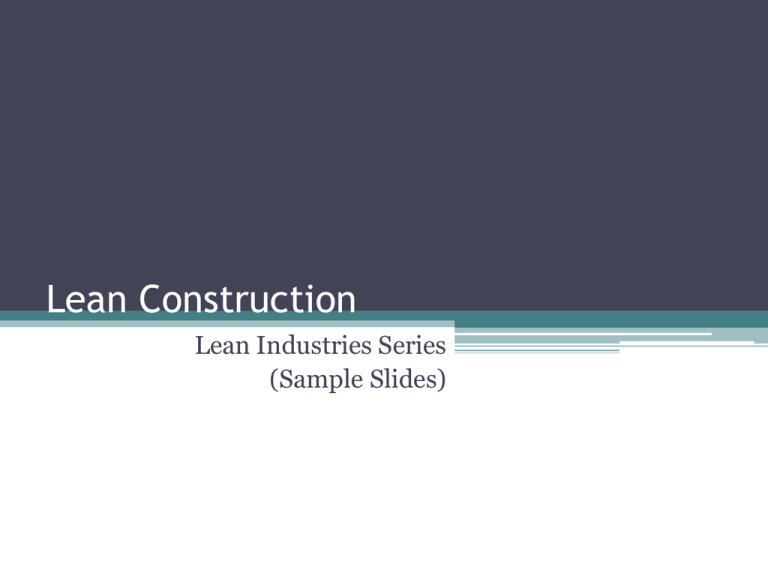
Lean Construction Lean Industries Series (Sample Slides) Topics • What is Lean? • What is Lean Construction? • Benefits of Lean Construction • Elements of Lean Construction • Applying Lean Thinking in Construction • Summary • The Bottom Line What is Lean Construction? • Six Goals of Lean Construction 1. Finished building will deliver maximum functionality 2. End users will benefit from the lowest optimum cost of ownership 3. Inefficiency and waste in the use of labor and materials will be eliminated 4. Specialist suppliers will be involved in design from the outset to achieve integration and buildability 5. Design and construction will be through a single point of contact for the most effective coordination and clarity of responsibility 6. Current performance and improvement achievements will be established by measurement Elements of Lean Construction Lean Project Delivery System Reference: Ballard 2000 Elements of Lean Construction Lean Project Delivery System • Essential features of LPDS include: ▫ The project is structured and managed as a value generating process ▫ Downstream stakeholders are involved in front end planning and design through cross functional teams ▫ Project control has the job execution as opposed to reliance on after-the-fact variance detection ▫ Optimization efforts are focused on making work flow reliable as opposed to improving productivity ▫ Pull techniques are used to govern the flow of materials and information through networks of cooperating specialists ▫ Capacity and inventory buffers are used to absorb variability ▫ Feedback loops are incorporated at every level for rapid system adjustment Reference: Ballard 2000 Applying Lean Construction Pacific Contracting of San Francisco, a specialist cladding and roofing contractor, have used the principles of lean thinking to increase their annual turnover by 20% in 18 months with the same number of staff. The key to this success was improvement of the design and procurement processes in order to facilitate construction on site, investing in the front end of projects to reduce costs and construction times. They identified two major problems to achieving flow in the whole construction process – inefficient supply of materials which prevented site operations from flowing smoothly and poor design information from the prime contractor, which frequently resulted in a large amount of redesign work. To tackle these problems Pacific Contracting combined more efficient use of technology with tools for improving planning of construction processes. They use a computerized 3D design system to provide a better, faster method of redesign that leads to better construction information. They also use a process planning too known as Last Planner, developed by Glen Ballard of the Lean Construction Institute, to improve the flow of work on site through reducing constraints such as lack of materials or labor. Case study taken from Rethinking Construction, the Report of the Construction Task Force Summary • Lean construction is a different way to see, understand and act in the world of construction • Lean construction is a philosophy – a comprehensive system of ideas that lead to the flawless delivery of the built environment • Lean construction is practiced using the Lean Project Delivery System, which continues to evolve as more is learned from practice and research Summary • Lean construction can be pursued through a number of different approaches to manage and improve the construction process to profitably deliver what the customer needs • Using tools like LPS will help the project team understand how they can improve the clarity of information and ensure there are sufficient operatives Summary • Lean Construction Principles: ▫ Eliminate waste ▫ Precisely specify value from the perspective of the ultimate customer ▫ Clearly identify the process that delivers what the customer values and eliminate all non value adding steps ▫ Make the remaining value adding steps flow without interruption by managing the interfaces between different steps ▫ Let the customer pull – don’t make anything until it is needed, then make it quickly ▫ Pursue perfection by continuous improvement The Bottom Line The lean principles can only be applied fully and effectively in construction by focusing on improving the whole process. This means all parties have to be committed, involved, and work to overcome obstacles that may arise from traditional construction projects.


